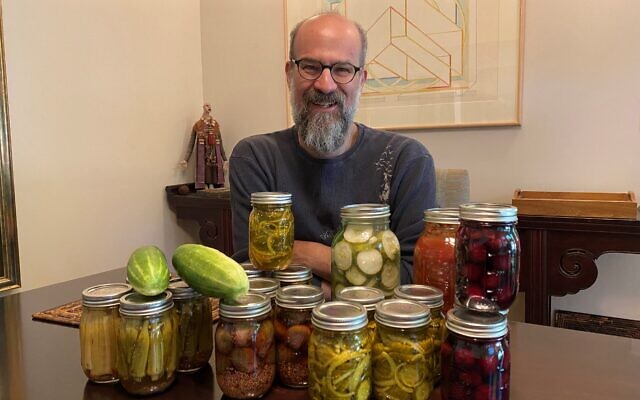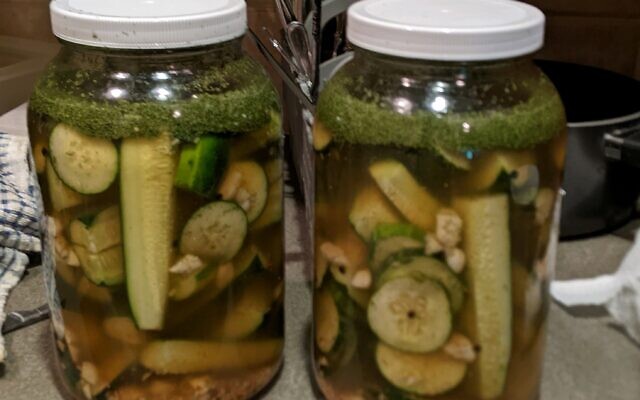Pucker Up for Crunch and Intense Flavor
At-home sheltering motivates some to bake bread and clean baseboards, others have entered the do-it-yourself foray into kosher style pickling.
After 37 years with the Atlanta Journal-Constitution and now with the AJT, , Jaffe’s focus is lifestyle, art, dining, fashion, and community events with emphasis on Jewish movers and shakers.

Pickles date as far back as 2030 B.C.E., when cucumbers from native India were pickled in the Tigris Valley. The word pickle comes from the Dutch pekel or northern German pókel, meaning salt or brine, two important components in the process.
How about the pregnant woman wanting to combine pickles with ice cream?
Everyone can conjure up a fun pickle memory. I recall gorging on the complimentary pickles at Wolfie’s and Pumperniks on Miami vacations. My brother recalls being an under-funded Georgia Tech student in the early ‘60s going with the frat boys to downtown Leb’s to fill up on a 35-cent cup of soup, free rolls and pickles. Today delis continue the tradition of serving a free pickle wedge as a sandwich accompaniment.
In “The Book of Jewish Food,” Claudia Roden describes the pickle’s role as a staple in the Ukrainian, Polish and Lithuanian diets with “its sharp flavor as a contrast to a boring diet of potatoes and bland bread. Pickles and other fermented foods like beets and cabbage lasted through the bitter winters.” Riga, Latvia, native Berta Mebel recalled, “My aunt made pickles to eat in cold winters. They were kept in small barrels in the crawl space under the kitchen floor. It was a delicacy to share at family gatherings after vodka.”
 Home pickling had two boons around 1850: the wax seal and the invention of hard durable glass Mason jars. The English added their take by sweetening the recipes. Middle Easterners serve pickles with peppers, olives and lemon.
Home pickling had two boons around 1850: the wax seal and the invention of hard durable glass Mason jars. The English added their take by sweetening the recipes. Middle Easterners serve pickles with peppers, olives and lemon.
Koreans contributed kimchi. All reputed to be good for the digestion.
Jews from Eastern Europe introduced pickles to America around 1900. Pushcarts, pickles in barrels filled the tenements.
Goldbergs Fine Foods executive chef Marshall Rogers said the restaurant preps and serves 3,000 pickles a day. Goldbergs pickles are sourced from New York according to their recipe standards “the old-fashioned way.” Per Rogers, “Pickles are a classic complement to any deli sandwich. The crisp, sour, sweet refreshing taste cuts through the rich fatty flavors of deli style sandwiches. There are few better combinations in the culinary world.”
Goldbergs carries full sours, half sours, dills, and bread and butters.
Stephanie Anchor and son Zach, 12, wanted to have a summer project. “We are self-acclaimed foodies and wanted to make a different and easy treat,” Stephanie said. “We learned to take our time and be flexible with ingredients. Our pickles ended up crunchy and mellow with only a 10-minute prep. We had them sit in brine for three days, reuse the brine to add other veggies like carrots, celery or onions.”
Anchor’s shorter fermentation time produced a brighter green half sour with roughly a $4 cost.
Zach added, “Have fun in the kitchen with your co-chefs. I also enjoyed delivering and sharing jars with neighbors.”
Robert Fierman had robust success with a July batch spanning seven days.
“Pickles make the best snack. There is potassium, but they are low in calories. My grandmother pickled Kirbys during the early ’50s. When I took my first bite from her wooden barrel, it spun my head. It’s as memorable as my first Coca-Cola!”
Home gardener and vegan chef Rabbi Hillel Norry grows and pickles his own bounty of jalapeños, zucchini, cukes and tomatoes. He instructs, “There are two ways to pickle: salt brine and can in vinegar. The variety is limitless: cabbage, okra, strawberries, even pineapple.”
Norry learned pickling in his parent’s garage where his mom made 80 quarts from local farm stands to share. Norry’s advice, “Get a pickling book. Use good quality cucumbers, not thinking that old cukes should be used. Good cucumbers made good pickles.”
Grandma Fierman’s Recipe (adapted)
1 gallon glass jar or ceramic crock
1/2 gallon of warm water (tap is fine)
Handful of fresh, clean grape oak, or
cherry leaves
3 to 4 pounds of cukes. If large, cut
into spears
5 to 6 tablespoons non-iodized sea
salt
2 to 3 heads of garlic, separated into
cloves, peeled. roughly chopped
3 tablespoons whole dill seed
2 tablespoons whole coriander seed
1 teaspoon whole mustard seed
(brown or yellow)
1 teaspoon whole peppercorns
1 teaspoon fennel seed
1/2 teaspoon red pepper flakes
Mix all ingredients and put into glass jar, cover with warm water. Seal. Store 5 to 7 days.
Anchor’s Easy Crunchy Recipe
2 to 3 pint jars
3 springs fresh dill
3 cloves garlic
2 teaspoons peppercorns
6 to 8 cukes, cut
2 cups white vinegar
2 cups water
2 tablespoons salt, optional
Put spices at bottom of the jars. Leave room at top of jar. Cover with vinegar and water. Seal jar and refrigerate for 3 days.
Rabbi Norry’s Bread and Butter Pickles
(“Ball Blue Book of Preserving”)
4 pounds cukes, cut into ¼-inch slices
8 small onions, sliced
1/3 cup canning salt
2 cups sugar
2 tablespoons mustard seed
2 teaspoons turmeric
2 teaspoons celery seed
1 teaspoon ginger
1 teaspoon peppercorns
3 cups vinegar
Combine cukes with onions in large bowl layered with salt. Cover with ice cubes.
Let stand 90 minutes. Drain, rinse, drain again. Combine remaining ingredients in large saucepot. Bring to a boil. Add drained cukes and onions and return to boil.
Pack hot pickles and liquid into hot jars, leaving 1/4-inch headspace. Remove air bubbles. Adjust 2-piece caps. Process 10 minutes in a boiling water canner.




comments